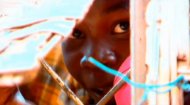|
|
|
Angola Education |
Angola Education |
Angola Education | Angola Education |
For information, videos and photos about the country of
Angola, check out our Angola profile pages.
More >
|

|
This is because although teachers are funded by the state, that funding doesn't cover books and furniture. As such, its not uncommon to see children in rural communities carrying their own chair to school on their head. Other schools don't have windows or roofs, so, when it rains, the children are sent home. In some schools like the one pictured below right, classes are run in outdoor school yards. As one teacher commented, "We lack everything from school books to desks, water and sanitation facilities, computers, libraries, and other basic learning materials. The other big problem is overcrowding." Education in Angola consists of eight years of primary education (Ensino de Base) starting at 6yrs old with class sizes of around 42 children, then three years of secondary education (Ensino Medio) which is a three-year general course or a four-year technical/vocational course culminating in the Habilitacos Literarias followed by tertiary education, although this has only a 0.7% take-up. For many primary education is divided into two periods ending the eight years of compulsory education. One of Angola's Millennium Development goals set for 2015 was to ensure that, by then, children everywhere, boys and girls alike, would be able to complete a full course of primary schooling and today, although thet goal hasn't be even closley reached, more children than ever before are enrolled in primary school with the number of girls attending the same as for boys. Angola currently spends 3.4213% of GDP on education, whilst Zambia spends 4.6181% and Nambia 8% (the UK spends 6.3%). This is despite the fact that Angola is Africa's biggest oil producer after Nigeria and the country is technically well off. Part of the problem is the nature of the country's government which tolerates little dissent so those who criticise the government in a bid to drive up standards can face arrest and jail. Without a better educated population at a higher level this situation is unlikely to change in the near future. To add to the difficulties, many children who now attend school have emotional and behavioural difficulties having been traumatized as child soldiers or witnessed severe brutality with parents being killed during the war. Many of the children are also disabled from the war, some victims of landmines. As ever enrolment rates become poorer the more rural the area and as with many other African countries education is seen as less of a priority for girls with higher drop out rates and poorer attendance sometimes as low as 40%. The short video (above) gives an insight into classroom education in Angola. |










